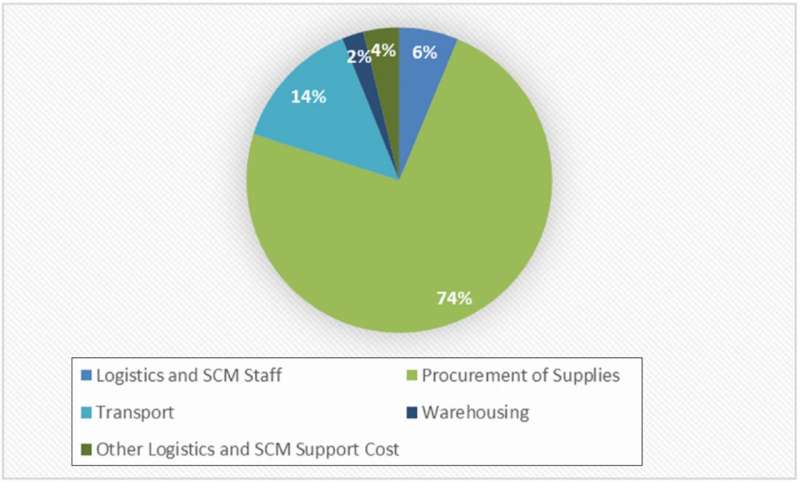Emergency relief: More efficient supply chains mean more help for every euro donated

When it comes to delivering humanitarian aid, 75 percent of the costs involved stem from supply chain management. Consequently, if focused savings measures were implemented throughout the supply chain, more of the money donated, and therefore more urgently needed help, could make its way to areas hit by catastrophes.
These are the key findings of a new study that Prof. Dr. Maria Besiou, Professor of Humanitarian Logistics at Kühne Logistics University (KLU) and two co-authors conducted. Their analysis was based on data from 14 disaster response operations implemented around the globe by five international aid organizations between 2005 and 2018.
Geopolitical crises involving military conflicts; global pandemics and supply bottlenecks; and natural catastrophes: Around the globe, humanitarian aid organizations have their hands full. As such, the finding that, for every euro donated to humanitarian aid, on average 75 cents go to supply chain management (SCM), becomes all the more important. Within SCM, the three major sources of costs are procurement, transport and human resources.
These are the conclusions reached by Prof. Dr. Maria Besiou, Professor of Humanitarian Logistics and Director of the Center of Humanitarian Logistics and Regional Development (CHORD) at KLU, in a study launched on the heels of the first World Humanitarian Summit in Istanbul (2016).
Together with Dr. Jonas Stumpf (HELP Logistics, Kühne Foundation) and Prof. Tina Wakolbinger, Ph.D. (Vienna University of Economics and Business), Besiou embarked on a mission to get to the bottom of the often-cited but never verified claim that 60 to 80 percent of the costs of humanitarian disaster response operations stem from SCM. Further goals were to identify areas and approaches for saving costs, and to shed light on the general role of logistics in connection with aid organizations.
Wars and pandemics: Logistics are especially costly
Five aid organizations shared their data on 20 disaster response operations in 14 countries between 2005 and 2018. On this basis, Besiou made her first calculations in 2021, while also engaging in talks with experts. The “60 to 80 percent” thesis stood up to analysis: Approximately 203 million of the 276 million euros that the five organizations spent on the 20 operations went to SCM—that’s 75 percent on average.
Where military conflicts and epidemics were involved, the logistics costs were especially high. In the researchers’ view, these findings are clear evidence of the crucial part played by supply chain decision-makers in delivering efficient and therefore successful relief operations.
Cost-saving approaches: Local, preventive and collaborative
In addition, Besiou and her co-authors developed new approaches intended to reduce logistics costs for aid organizations. Here, preparation is the key. According to Besiou: “For example, providing training for local staff in advance is a sound investment. Then, when a catastrophe occurs, there’s no need to bring in external staff, which can cost 5 to 15 times as much.” Moreover, locals are more familiar with the prevailing market structures and security aspects.
Long-term agreements with suppliers also pay off, as do special money-and-voucher programs, which allow people struck by catastrophes to choose for themselves what they need most, or to trade among themselves. After all, this avoids transport and storage costs—and means that local markets, assuming they’re still working, aren’t brought to a standstill by external aid products.
Further, collaborations between aid organizations in the form of capacity sharing or joint procurement strategies can reduce SCM costs, according to the study—not to mention detailed planning in the preparation phase, which should address the corresponding codetermination rights and responsibilities of SCM staff.
Make supply chain managers part of the coordinating team
Whereas the study in question focused on major international aid organizations with traditional structures and based in Europe, the next step will require evaluating supply-chain costs at the local level, so as to identify further cost-saving potentials.
“For the public, supply chains always become a topic when something doesn’t work—like the bottlenecks for medical masks early in the COVID-19 pandemic, or when a container ship blocked the Suez Canal for several days,” Besiou summarizes. The public often underestimates the vital role of supply chains; as a result, too little attention, time and money are invested in logistics. This also means that decision-makers for supply chain management are often underrepresented on the Executive Boards of aid organizations.
“As our study shows: In order to ensure that donated funds are optimally used to provide aid on-site, logistics specialists with considerable practical experience have to be involved as early as possible—ideally, during the planning phase—so that disaster response operations can be carried out efficiently and effectively.”
The findings are published in the Journal of Humanitarian Logistics and Supply Chain Management.
More information:
Jonas Stumpf et al, Assessing the value of supply chain management in the humanitarian context—An evidence-based research approach, Journal of Humanitarian Logistics and Supply Chain Management (2022). DOI: 10.1108/JHLSCM-03-2022-0039
Provided by
Kühne Logistics University
Citation:
Emergency relief: More efficient supply chains mean more help for every euro donated (2023, June 16)
retrieved 16 June 2023
from https://phys.org/news/2023-06-emergency-relief-efficient-chains-euro.html
This document is subject to copyright. Apart from any fair dealing for the purpose of private study or research, no
part may be reproduced without the written permission. The content is provided for information purposes only.
For all the latest Science News Click Here
For the latest news and updates, follow us on Google News.

